PTG Unit

PTG unit is located in rear left luggage side trim.
PTG drive unit drive the two actuators (Spindles) by measuring the driving motors.
PTG unit also controls anti trap functions by hall sensor analysis in the anti-pinch strip.
Power tailgate is an electro-mechanical system designed to provide power opening and closing of the tailgate through the push of a button of a remote key (fob), console switch, inner switch or an outside handle switch of the tailgate.
The power tailgate will reverse direction of travel if resistance to movement is detected while the tailgate is being opened or closed.
The PTG system will measure the Tailgate position via an integrated hall sensor inside the Spindle drive unit motor.
The moving direction of tailgate will be detected by analyzing the direction of the drive unit motor.
The hall sensor pulse counting (position detection) is active during power and manual operation mode.
PTG Unit

PTG unit is located in rear left luggage side trim.
PTG drive unit drive the two actuators (Spindles) by measuring the driving motors.
PTG unit also controls anti trap functions by hall sensor analysis in the anti-pinch strip.
PTG Latch Assembly
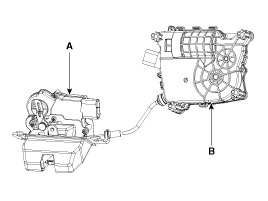
PTG latch assembly is consist of Power Latch (A) and Power Closeing Unit (B).
Power latch is located in the lower part of tail gate panel.
PTG Spindle
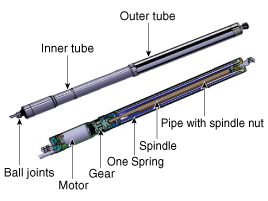
PTG spindle open and close the tailgate by driving the motor.
Anti-Pinch Strip

During power closing or cinching, the PTG system shall reverse to full open if an anti-pinch strip signal is received. However, the anti-pinch strips will not work when the Tailgate is idle in the full closed, full open, or stopped positions.
SMK (Smart key)
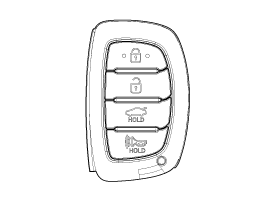
Push the power tailgate open of the SMK more than 0.5s to open the power tailgate. Power Open operation shall be reversed when an additional Open/Close signal is received during power opening.
Interrior Swtich

Tailgate inner switch
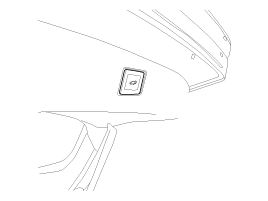
Tailgate buzzer

When a power operation cannot be performed as requested or an obstacle has been detected.

** - Primary switch signal received by PTGM via CAN bus (sent by SJB)
Opening can be triggered after a signal is received from, driver-console switch, outside handle switch, remote Key (FOB)
The latch will be released (by SJB) by actuation of latch motor.
On latch release, the tailgate latch pops out of the striker.
PTG module controls the tailgate motor in order to open the tailgate.
The rotating speed of the tailgate motor can be hall sensor that is built in the motor.
Opening angle of the tailgate is calculated by counting the input pulse signals from Hall sensor.
When the motor movement is restricted, the PTGM stops the tailgate motor movement due to obstacle detection.
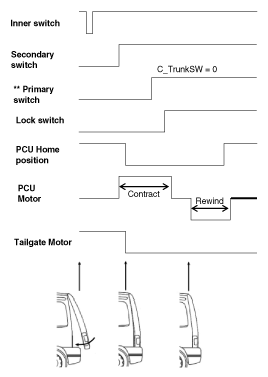
Closing can be triggered after receiving a signal from, console (driver) switch, ouside handle switch, remote key (FOB), inner switch
PTG module controls the tailgate motor in order to close the tailgate
Closing angle of the tailgate is calculated by counting the input pulse signlas from hall sensor
The rotating speed of the tailgate motor can be hall sensor that is built in the motor
The tailgate latch engages with the striker and the latch is locked mechanically (Latch unlock → Latch lock)
PTGM stops the tailgate motor operation after detecting the tailgate latch's secondary signal
On detecting the latch's secondary signal, the power close unit (PCU) starts the contract (cinch) operation and stops after the latch lock signal is detected
After contract operation is stopped, PCU is rewound until the PCU home position is reached
The tailgate is completely closed and latch is fully locked
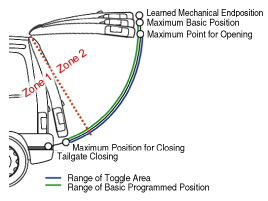
Maximum Point for Opening
Above this position a start in opening direction could make the tailgate move beyond the Maximum Basic Position and overload the mechanical system (hinges).
Therefore the start of an opening action above this point is disabled.
Anyway the tailgate moves beyond this point, if it has been started at a lower position.
Learned Mechanical End Position
This is the mechanical block position while opening and is considered to be 100% opening. During the first tailgate opening this position is learned.
After learning, the tailgate will not move beyond the Maximum Basic Position, which is defined by the Learned Mechanical Position – Security Distance.
All positions are defined by parameters in the ECU or programmed by the user (Basic Programmed Position)
The customizable Programmed Basic Position is set equal to the Maximum Basic Position after the Learned Mechanical End Position is learned.
The customer can change the Programmed Basic Position to any new position between the Maximum Point For Closing and the Maximum Basic Position.
If the customer wants to set a new Programmed Basic Position below the actual Programmed Basic Position, he has to move the tailgate electrically or manually to the new position and has to push the Inner Switch for e.g. 3 seconds (time can be modified by parameter)
If the customer wants to set a new Programmed Basic Position above the actual Programmed Basic Position he has to move the tailgate manually to the new position and has to push the Inner Switch for 5 seconds (time can be modified by parameter)
If the user tries to program a tailgate position above the Maximum Basic Position, the ECU will set the Programmed Basic Position to the Maximum Basic Position.
Due to mechanical tolerances and adjustments in vehicle production and assembly the power operated tailgate needs calibration of the maximum movement range before proper operation can be ensured.
The tailgate’s maximum movement range is represented by the number of Hall-pulses received by the ECU from the actuators’ speed / position sensors during a tailgate movement from the fully closed position (closure unit in fully latched position) to the upper end position limited by mechanical constraints (e.g. upper bump stops, spindle length or similar).
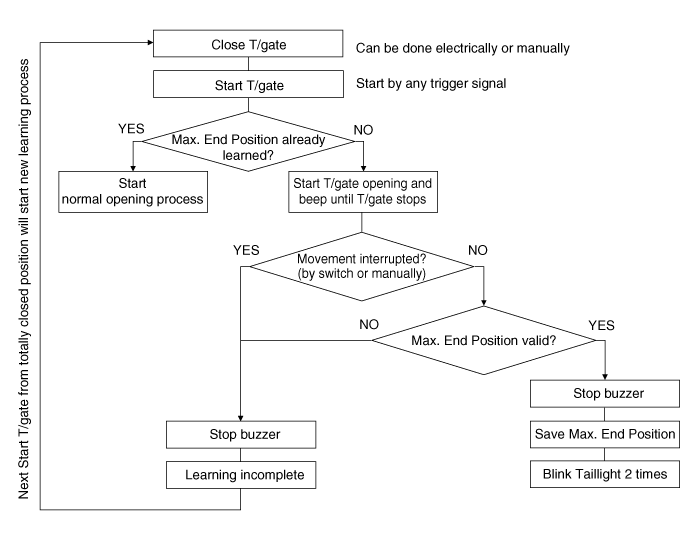
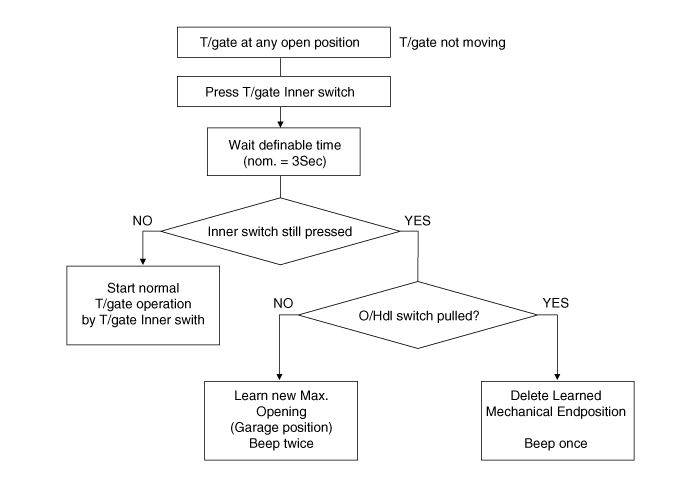
System initialization is necessary to identify the Tailgate closed (0-Position) position.
After a Battery Power-on reset, an initialization process must be executed to find the full open and full closed Tailgate position. After successful initialization for Tailgate closed position and learning of the Tailgate full open position the normal Tailgate open and close operation can be ensured.
Procedure:
After Power-on, the Latch status is checked to identify the Tailgate position status.
If the Latch is open, it is assumed that Tailgate is open and the inner switch illumination is switched on
If the Latch is closed, it is assumed that Tailgate is closed. Therefore, the Tailgate position is set to zero and the initialization is completed.
BUZZER | LAMP *) | Remark | |
T/gate start | 2 times | 2 times | When T/gate is triggered by Remote Contol or T/gate Console Switch |
T/gate start | n.a. | n.a. | When T/gate is triggered by T/gate Inner Switch or T/gate Outer Handle Switch |
T/gate stop | n.a. | n.a. | |
System error | 3 Times | - | PCU/Tailgate antiplay active, 0ver-/undervoltage condition, Endposition-/position error, spindle error, CAN error, Latch closed when Tailgate open |
T/gate not closed | 10 times | 10 times | Latch Lock Switch not present |
During Calibration run | Continuous ON-OFF beeping | n.a. | Activate buzzer but not C_PTHazard |
Max. End Position learned | n.a. | 2 times | Buzzer confirms learning finished |
Max. End Position deleted | 1 time | n.a. | Buzzer confirms "position deleted" |
Car is moving with open T/gate | Continuous ON-OFF beeping | n.a. | T/gate open AND Speed >3km/h |
Garage Position saved | 2 times | n.a. | Buzzer confirms "New Garage Position" |
*) Lamp will be synchronized by sending C_PTHazard simultaneously to Buzzer signal